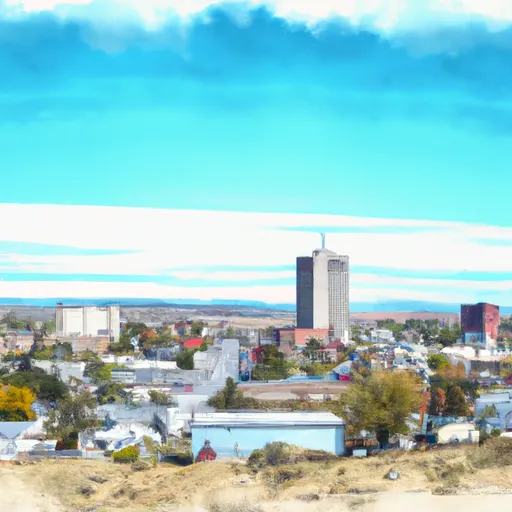-
 Snoflo Premium
Snoflo Premium
Get unlimited access to all our content
With no Ad interruptions! - Start Your Free Trial Login with existing account
Havre
Eden Index
Climate
6.7
•
Recreation
2.3
•
Community
•
Safeguard
3.5/10

Havre is a city located in north-central Montana with a population of around 9,000 people. The climate in Havre is characterized by cold winters and hot summers, with average temperatures ranging from 15°F in January to 80°F in July. The Milk River runs through the city, and it is a source of drinking water for the community. Hydrology constituents in the area include nitrate, sulfate, and total dissolved solids. Outdoor recreation opportunities in Havre include hiking, fishing, camping, and hunting, as well as winter sports such as skiing and snowmobiling. The city is also home to the Beaver Creek Park, which is the largest county park in the United States and offers numerous recreational activities.
What is the Eden Index?
The Snoflo Eden Index serves as a comprehensive rating system for regions, evaluating their desirability through a holistic assessment of climate health, outdoor recreation opportunities, and natural disaster risk, acknowledging the profound impact of these factors on livability and well-being.
Climate Health Indicator (CHI): 6.7
Havre receives approximately
303mm of rain per year,
with humidity levels near 69%
and air temperatures averaging around
6°C.
Havre has a plant hardyness factor of
4, meaning
plants and agriculture in this region thrive during a short period during spring and early summer. Most
plants will die off during the colder winter months.
By considering the ideal temperature range, reliable water supplies, clean air, and stable seasonal rain or snowpacks, the Climate Health Indicator (CHI) underscores the significance of a healthy climate as the foundation for quality living.
A healthy climate is paramount for ensuring a high quality of life and livability in a region, fostering both physical well-being and environmental harmony. This can be characterized by ideal temperatures, reliable access to water supplies, clean air, and consistent seasonal rain or snowpacks.
Weather Forecast
Streamflow Conditions
Milk
Area Rivers
Milk
Snowpack Depths
Milk
Reservoir Storage Capacity
Milk
Groundwater Levels
Recreational Opportunity Index (ROI): 2.3
The Recreational Opportunity Index (ROI) recognizes the value of outdoor recreational options, such as parks, hiking trails, camping sites, and fishing spots, while acknowledging that climate plays a pivotal role in ensuring the comfort and consistency of these experiences.
Access to outdoor recreational opportunities, encompassing activities such as parks, hiking, camping, and fishing, is crucial for overall well-being, and the climate plays a pivotal role in enabling and enhancing these experiences, ensuring that individuals can engage in nature-based activities comfortably and consistently.
Camping Areas
| Campground | Campsites | Reservations | Toilets | Showers | Elevation |
|---|---|---|---|---|---|
| Beaver Creek County Park | None | 3,670 ft | |||
| Fresno Tailwater FAS | None | 2,510 ft | |||
| Clack Museum Campground | None | 2,621 ft | |||
| Fresno Beach - Fresno Reservoir - USBR | None | 2,634 ft | |||
| Great Northern Fair and Campgrounds | None | 2,618 ft | |||
| River Run - Fresno Reservoir - USBR | None | 2,521 ft | |||
| Hill County Beaver Creek Park | None | 4,025 ft | |||
| Kiehns Bay - Fresno Reservoir - USBR | None | 2,594 ft | |||
| Bearpaw Lake FAS | None | 3,602 ft | |||
| Kremlin - Fresno Reservoir - USBR | None | 2,612 ft |
Nearby Ski Areas
Catastrophe Safeguard Index (CSI):
The Catastrophe Safeguard Index (CSI) recognizes that natural disaster risk, encompassing floods, fires, hurricanes, and tornadoes, can drastically affect safety and the overall appeal of an area.
The level of natural disaster risk in a region significantly affects safety and the overall livability, with climate change amplifying these risks by potentially increasing the frequency and intensity of events like floods, fires, hurricanes, and tornadoes, thereby posing substantial challenges to community resilience and well-being.
Community Resilience Indicator (CRI):
The Community Resilience Indicator (CRI) recognizes that education, healthcare, and socioeconomics are crucial to the well-being of a region. The CRI acknowledges the profound impact of these elements on residents' overall quality of life. By evaluating educational resources, healthcare accessibility, and economic inclusivity, the index captures the essential aspects that contribute to a thriving community, fostering resident satisfaction, equity, and social cohesion.

